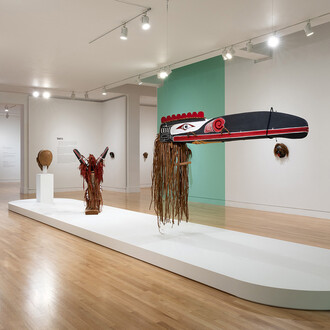In her first solo museum exhibition, One Gray Hair, Tlingit artist Alison Marks directly challenges the expectation that Native artists must perform exoticized markers of Native identity to be considered legitimate. Marks, whose practice spans a variety of mediums including painting, sculpture, digital collage, and regalia, is a passionate advocate for the health of the Tlingit language and culture. Her work fuses the seamless, flowing lines, trigons, and ovoids that create formline—the distinctive aesthetic of the Tlingit, Haida, and Tsimshian peoples of Southeast Alaska—with nontraditional materials, tools, and techniques as means of engaging with the evolving complexities posed by transcultural exchange in the twenty-first century.
The title of the exhibition stems from Marks' discovery of her first gray hair. This event prompted her to reflect on the contrast between customary Tlingit standards of female beauty, which value gray hair, and Western standards which decry it. The exhibition grows out of this uneven terrain between tradition and innovation, as Marks layers her observations of contemporary Native experience throughout the artworks on view. The strategy of subverting dominant images and narratives is central to her practice: some works use humor to counter the patriarchal and racial bias of the art historical canon, such as her digital manipulations of European paintings; others adopt the language of commercial advertising to address the endless appropriation of the totem pole.
In particular, Marks is observant of Natives’ use of—and reliance on—digital technology. A fully immersed participant in social media herself, Marks recognizes its appeal, impact, reach, and limitations. At a time when the Tlingit language is predicted to lose its speakers by 2030, she notices that the more frivolous uses offered by social media (ubiquitous selfies, emojis for communicating) are perhaps outweighing potential benefits such as Tlingit-language applications. As Tlingit culture continually shifts and adapts with new technologies, Marks is attentive to what may be gained and what may be lost.
The works that compose One Gray Hair hold up both a window and a mirror to the viewer. Marks enables us to see present-day Tlingit culture through her eyes, while allowing the world to see itself as it appears to a Tlingit woman. She asserts that Indigenous identity and expression are shaped as much by humor and available materials as by tradition.
Alison (Bremner) Marks (Tlingit, b. 1989) was born and raised in southeast Alaska. In addition to her contemporary art practice, Marks is committed to the revitalization of Tlingit culture and the creation of art for traditional and ceremonial use. She studied under master artists David R. Boxley and David A. Boxley in Kingston, Washington. Marks has participated in group exhibitions at, among others, the Bainbridge Island Museum of Art; Whatcom Museum, Bellingham; Château Musée Boulogne-sur-Mer, France; Art Mûr, Montreal; and Audain Gallery, Vancouver. Her work is held in numerous public collections at institutions such as the Burke Museum in Seattle; Portland Art Museum, Oregon; Sealaska Heritage Institute in Juneau, Alaska; and the British Museum in London.
Marks received the 2015 James W. Ray Venture Project Award, which is funded by the Raynier Institute & Foundation through the Frye Art Museum | Artist Trust Consortium. The award supports and advances the creative work of outstanding artists living and working in Washington State and culminates in an exhibition at the Frye Art Museum.
















